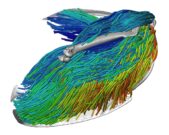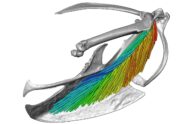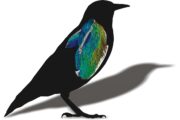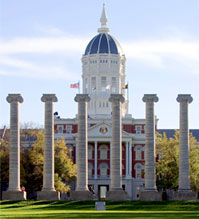Home / News Releases / 2019 / 0430 New Three Dimensional Imaging And Visualization Technique Provides Detailed Views Of Muscle Architecture / Image Description 8
Related Media Gallery for New three-dimensional imaging and visualization technique provides detailed views of muscle architecture
April 29th, 2019
-

-
Kevin Middleton
Kevin Middleton, an associate professor in the MU School of Medicine, and a team of scientists in pathology and anatomical sciences in the University of Missouri’s School of Medicine have revealed a three-dimensional view of the skeletal muscles responsible for flight in a European starling. Photo:
Photo:
Download larger image
-

-
Casey Holliday
Casey Holliday, an associate professor in the MU School of Medicine, and a team of scientists in pathology and anatomical sciences in the University of Missouri’s School of Medicine have revealed a three-dimensional view of the skeletal muscles responsible for flight in a European starling. Photo:
Photo:
Download larger image
-

-
Spiro Sullivan
Spiro Sullivan, a doctoral student in the MU School of Medicine, is the lead researcher on the study. Sullivan and a team of scientists in pathology and anatomical sciences in the University of Missouri’s School of Medicine have revealed a three-dimensional view of the skeletal muscles responsible for flight in a European starling. Photo:
Photo:
Download larger image
-

-
Faye McGechie
Faye McGechie, a doctoral student and Life Sciences Fellow at MU, co-authored the study and is applying this technology to understanding human evolution. Photo:
Photo:
Download larger image
-

-
Pectoral and shoulder muscle architecture in a European starling
In a new study, scientists in pathology and anatomical sciences in the University of Missouri’s School of Medicine have revealed a three-dimensional view of the skeletal muscles responsible for flight in a European starling. The study will form the basis of future research on the bird’s wishbone, which is supported by these particular muscles and is hypothesized to bend during flight. Photo:
Photo:
Download larger image
-

-
European starling pectoral muscle architecture
In a new study, scientists in pathology and anatomical sciences in the University of Missouri’s School of Medicine have revealed a three-dimensional view of the skeletal muscles responsible for flight in a European starling. The study will form the basis of future research on the bird’s wishbone, which is supported by these particular muscles and is hypothesized to bend during flight. Photo:
Photo:
Download larger image
-

-
Pectoral and shoulder muscle architecture in a European starling
In a new study, scientists in pathology and anatomical sciences in the University of Missouri’s School of Medicine have revealed a three-dimensional view of the skeletal muscles responsible for flight in a European starling. The study will form the basis of future research on the bird’s wishbone, which is supported by these particular muscles and is hypothesized to bend during flight. Photo:
Photo:
Download larger image

